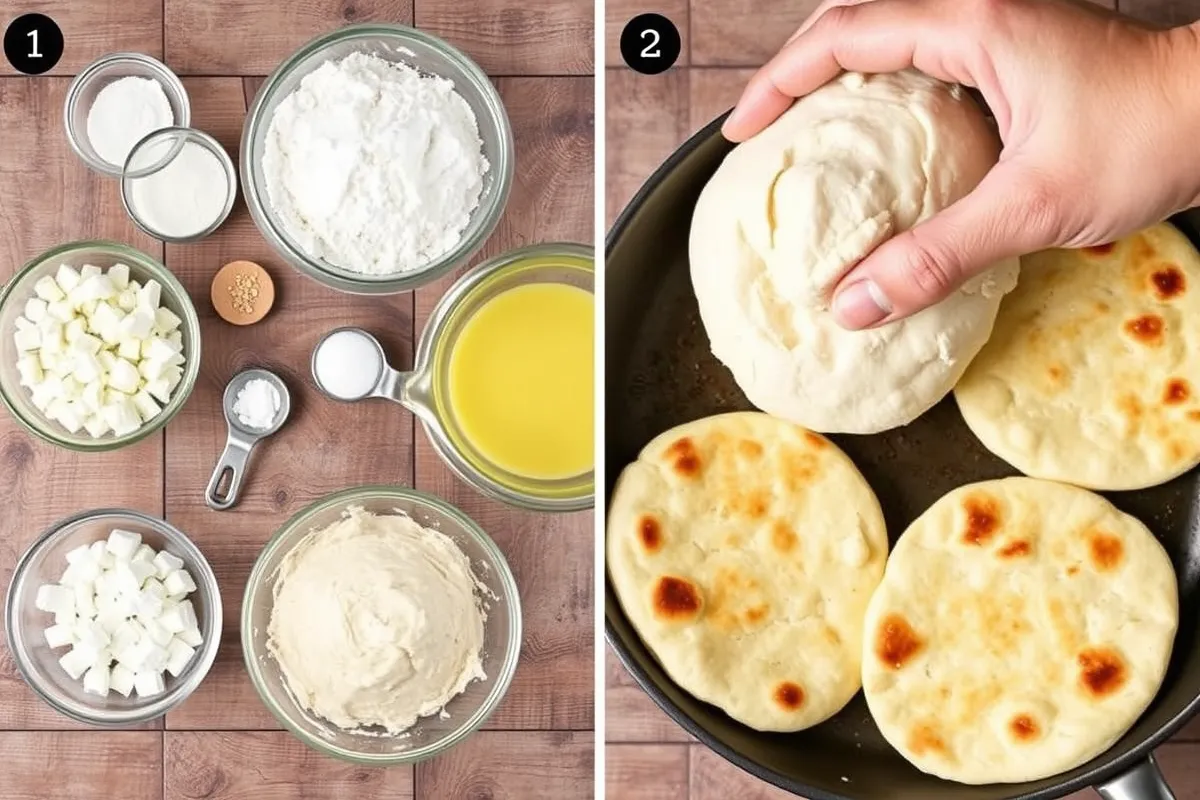Introduction :
If you’re someone who loves bread but needs an egg-free alternative, you’re in for a treat. This cottage cheese flatbread no egg recipe is a perfect option whether you’re avoiding eggs for allergies, health reasons, or personal preference. Cottage cheese steps up as a fantastic substitute, providing the richness and protein you need. In this article, we’ll explore why egg-free flatbread is gaining popularity, walk you through a simple recipe, and share creative variations to make it your own.
Cottage Cheese Flatbread No Egg: A Delicious Egg-Free Alternative
Have you ever wished you could enjoy soft, fluffy flatbread without worrying about eggs? You’re not alone! More people are seeking out egg-free flatbread recipes, and one ingredient making waves is cottage cheese. Why cottage cheese, you ask? Well, it’s creamy, versatile, and gives that perfect texture to the dough, all without the need for eggs. It’s not only a great protein source, but also keeps the bread soft and moist.
Cottage cheese flatbread no egg isn’t just a solution for people with egg allergies—it’s a wonderful option for anyone wanting to try a lighter, healthier bread option. The beauty of this recipe lies in its simplicity: minimal ingredients, a straightforward process, and, most importantly, the ability to customize it in countless ways. From savory additions like herbs and garlic to creative toppings, the possibilities are endless.
With the rise in plant-based and allergy-friendly diets, more people are looking for alternatives to traditional egg-based flatbread. Cottage cheese fills this gap beautifully, allowing you to enjoy flatbread that’s not only egg-free but also deliciously satisfying.
Why Choose Egg-Free Flatbread Recipes?
The Growing Demand for Egg-Free Recipes
In recent years, there has been a notable surge in demand for egg-free recipes. It’s no surprise, considering that many individuals have dietary restrictions or personal preferences that make them avoid eggs. Whether due to allergies, following a vegan lifestyle, or simply seeking healthier alternatives, many people are steering clear of eggs in their daily meals. For instance, those with egg allergies can’t risk even a trace, and that means regular flatbread recipes are off the table.
However, eliminating eggs from traditional flatbread recipes isn’t always a walk in the park. Eggs often provide structure, moisture, and richness, so when you remove them, finding suitable replacements that maintain the flatbread’s desired texture can be tricky. Luckily, cottage cheese offers an easy fix. It not only acts as a protein-rich alternative but also binds the ingredients beautifully, ensuring your flatbread stays soft and flavorful.
Nutritional Benefits of Egg-Free Flatbread
One major reason to opt for egg-free flatbread is its health benefits. By using cottage cheese as a key ingredient, you’re cutting down on the fat and cholesterol typically found in egg-based recipes. Cottage cheese is also high in protein, which is essential for muscle repair and satiety. So, in addition to keeping things light, this flatbread is packed with nutritional goodness.
Compared to traditional flatbread that contains eggs, cottage cheese flatbread no egg is a much lower-fat alternative. The absence of eggs significantly reduces the calorie and fat content, while still offering that delicious soft texture everyone loves in a flatbread.
Who Should Try Cottage Cheese Flatbread No Egg?
Egg-free cottage cheese flatbread isn’t just for those with allergies. It’s also a great fit for several dietary groups. Vegetarians, for example, can enjoy the protein boost from cottage cheese, while those on low-carb or keto diets will appreciate how easy it is to modify this recipe with low-carb flours like almond or coconut flour. Even if you’re simply trying to make healthier choices, this recipe offers a guilt-free way to enjoy bread without compromising on flavor or nutrition.
Ingredients Needed for Cottage Cheese Flatbread No Egg
Essential Ingredients for Cottage Cheese Flatbread No Egg
To make this cottage cheese flatbread no egg recipe, you don’t need a long list of fancy ingredients. In fact, part of what makes this recipe so appealing is its simplicity. Here are the basic ingredients you’ll need:
- Cottage Cheese: This is the star of the recipe, providing moisture, protein, and structure to the flatbread.
- Flour: Depending on your dietary preference, you can use all-purpose flour, whole wheat, or even almond flour if you’re going gluten-free or on a low-carb flatbread diet.
- Baking Powder: This helps the flatbread rise slightly, giving it a soft and fluffy texture.
- Salt: Just a pinch, to enhance the flavor.
- Herbs and Spices (Optional): To add a burst of flavor, you can include garlic powder, thyme, oregano, or any herb of your choice.
Ingredient Substitutes and Variations
One of the great things about cottage cheese flatbread is how easy it is to adapt the recipe to suit different dietary needs. If you’re gluten-free, you can replace regular flour with almond flour or a gluten-free flour blend. This still gives the bread that soft, doughy texture while keeping it gluten-free.
For those following a vegan diet, replacing cottage cheese might seem tricky, but fear not! Vegan alternatives like tofu-based cottage cheese or cashew cheese work wonderfully in this recipe. Another option is ricotta for a different texture, or you could experiment with vegan-friendly cheese options that mimic the texture and moisture of cottage cheese.
Step-by-Step Recipe for Cottage Cheese Flatbread No Egg
How to Make Cottage Cheese Flatbread Without Eggs
Now that you know the ingredients, let’s get to the fun part—making your own cottage cheese flatbread no egg from scratch! This recipe is perfect for beginners or anyone looking for a quick, healthy bread option that’s free from eggs.

Preparation Time and Cooking Time
You’ll be pleased to know that this recipe doesn’t take long to prepare. From start to finish, you’re looking at about:
- Prep time: 10 minutes
- Cook time: 20 minutes
In under half an hour, you’ll have fresh, warm flatbread ready to enjoy!
Step-by-Step Instructions
- Gather Your Ingredients: Make sure you have all your ingredients measured out and ready to go.
- Mix the Dry Ingredients: In a large bowl, whisk together the flour, baking powder, and salt. This ensures an even distribution of the leavening agent and flavor.
- Add the Cottage Cheese: Fold the cottage cheese into the dry ingredients. You’ll want to mix just until everything is combined, forming a soft dough. Avoid overmixing, as this can make the flatbread dense.
- Shape the Dough: Once the dough is mixed, divide it into equal portions and shape each into a flat round. If the dough is sticky, lightly flour your hands.
- Cook the Flatbread: Heat a non-stick skillet over medium heat. Cook each flatbread for about 2-3 minutes on each side, until they are golden brown with a few dark spots for that perfect flatbread look.
- Serve and Enjoy: Once cooked, you can enjoy the flatbread warm, either on its own or paired with your favorite toppings or dips.
Tips for Perfecting Your Egg-Free Flatbread
- Don’t Overmix: When combining your dough, less is more. Overmixing can lead to a tougher flatbread, which is something we want to avoid.
- Watch the Heat: Flatbread cooks quickly, so keep an eye on your skillet to prevent burning. You want a nice golden-brown color, not blackened edges.
- Use Fresh Ingredients: Fresh cottage cheese and baking powder will give you the best rise and flavor, so always check the dates on your ingredients before starting.
Health Benefits of Cottage Cheese in Flatbread Recipes
Nutritional Value of Cottage Cheese
When it comes to adding nutritional value, cottage cheese is a superstar. It’s packed with essential nutrients like protein and calcium, which are crucial for maintaining strong bones and overall health. One serving of cottage cheese typically provides around 12 to 15 grams of high-quality protein, making it an excellent ingredient for a protein-rich flatbread.
In terms of calcium, cottage cheese also delivers a solid dose, supporting bone density and muscle function. Plus, it contains various vitamins and minerals such as vitamin B12, phosphorus, and selenium. When you compare this to traditional egg-based flatbread, which often carries higher fat and cholesterol, cottage cheese flatbread offers a lighter, healthier alternative.
Protein and Low-Fat Content
One of the major benefits of using cottage cheese in your flatbread is that it’s naturally high in protein yet low in fat. Protein, as we know, plays a key role in building and repairing tissues, and it also helps keep you full for longer. For those looking to manage their weight, this is a big win. Each bite of cottage cheese flatbread gives you a satisfying protein boost without the need for eggs or high-fat ingredients.
On top of that, the reduced fat content in cottage cheese, especially if you opt for low-fat or fat-free varieties, makes this flatbread a heart-healthy choice. It’s perfect for supporting muscle growth, especially post-workout, and can help keep cravings at bay thanks to its satiety benefits.
Cottage Cheese and Digestive Health
Did you know that some types of cottage cheese also contain probiotics? Probiotics are live bacteria that are good for your gut, helping to maintain a healthy balance of microorganisms in your digestive system. This can improve digestion and boost your immune system. Incorporating cottage cheese into your flatbread recipe not only supports muscle growth but also contributes to better digestive health, especially if you choose probiotic-rich brands.
Nutritional Content (Per 100g)
Below is the nutritional breakdown of cottage cheese flatbread no egg (values are approximations):
| Nutrient | Amount per 100g |
|---|---|
| Calories | 210 kcal |
| Protein | 12 g |
| Total Fat | 8 g |
| Saturated Fat | 3 g |
| Carbohydrates | 20 g |
| Fiber | 2 g |
| Sugar | 1 g |
| Calcium | 150 mg |
| Sodium | 320 mg |
Popular Variations and Serving Ideas

Creative Variations of Cottage Cheese Flatbread No Egg
The beauty of cottage cheese flatbread no egg lies in its versatility. You can tweak the basic recipe to suit various dietary needs and preferences without compromising flavor.
Gluten-Free Cottage Cheese Flatbread
If you’re following a gluten-free diet, no problem! Simply swap out regular flour with almond flour or coconut flour. These alternatives not only keep the flatbread gluten-free but also enhance its nutritional profile by reducing the carb count, making it an ideal option for those on a low-carb or keto diet. Almond flour adds a subtle nutty flavor, while coconut flour keeps it light and fluffy. Just be sure to adjust the liquid ratios, as coconut flour tends to absorb more moisture.
Vegan Cottage Cheese Flatbread
For those embracing a vegan lifestyle, you might be wondering how to replace cottage cheese in this recipe. Well, vegan cheese substitutes made from cashews or tofu work perfectly. You can also opt for plant-based cottage cheese, which mimics the texture and moisture of dairy-based versions. Combined with whole wheat or spelt flour, this vegan version is just as delicious and satisfying, offering a plant-powered boost to your meals.
Best Ways to Serve Cottage Cheese Flatbread
Once you’ve perfected your cottage cheese flatbread no egg, the next step is figuring out how to enjoy it. Thankfully, the options are endless!
Breakfast Ideas
For a nutritious start to the day, serve your flatbread alongside some creamy avocado, fresh hummus, or dairy-free spreads. Add a sprinkle of seeds or herbs for an extra pop of flavor. You can even enjoy it on its own as a light morning snack.
Lunch and Dinner Pairings
Cottage cheese flatbread makes for a fantastic accompaniment to soups, salads, or roasted vegetables. Try it with a bowl of hearty tomato soup or paired with a fresh Greek salad for a filling, balanced meal. It’s also great with grilled vegetables, offering a wholesome side that complements the main dish.
Using Flatbread as a Pizza Base
Who doesn’t love a good pizza? Turn your cottage cheese flatbread into a low-carb pizza base by topping it with tomatoes, fresh herbs, and your favorite cheese (or dairy-free alternatives). Bake it until the cheese is bubbly, and you’ve got yourself a delicious, homemade flatbread pizza that’s far healthier than the store-bought version.
Storing and Reheating Tips for Cottage Cheese Flatbread
How to Store Your Cottage Cheese Flatbread
Proper storage is key to maintaining the freshness and flavor of your flatbread. After cooking, allow the flatbread to cool completely before storing. You can keep your cottage cheese flatbread in the fridge for up to 3-4 days. To do this, place the flatbreads in an airtight container or wrap them tightly in plastic wrap or aluminum foil to prevent them from drying out.
For longer storage, freezing is a great option. Simply stack the flatbreads with a sheet of parchment paper between each one, place them in a ziplock bag, and freeze. They’ll keep well for up to a month.
Best Methods for Reheating Flatbread
When it comes to reheating, the method you choose will depend on the texture you’re after. If you like your flatbread soft, reheating it in the microwave for about 15-20 seconds should do the trick. On the other hand, if you prefer a bit of crispiness, pop the flatbread into a preheated oven at 350°F (175°C) for 5-7 minutes, or heat it in a skillet over medium heat for a few minutes on each side. Either way, your flatbread will come out warm and tasty, just like when it was freshly made!
Common Questions about Cottage Cheese Flatbread No Egg
Frequently Asked Questions (FAQs)
Can I make cottage cheese flatbread without flour?
Yes, you can! For a gluten-free or low-carb alternative, you can swap out traditional flour for almond flour or coconut flour. Almond flour works well for a nutty, denser texture, while coconut flour creates a lighter, fluffier flatbread. Keep in mind that coconut flour absorbs more liquid, so you may need to adjust the amount of cottage cheese or liquid in the recipe.
Is cottage cheese flatbread keto-friendly?
Absolutely! By using low-carb flours like almond or coconut flour, you can make this cottage cheese flatbread suitable for a keto diet. Cottage cheese itself is relatively low in carbs and high in protein, making it a great choice for keto-friendly baking.
Can I freeze cottage cheese flatbread?
Yes, you can freeze cottage cheese flatbread for later use. To do this, first let the flatbread cool completely, then stack the pieces with parchment paper between each one. Place them in an airtight bag or container and freeze. When you’re ready to eat, simply reheat the flatbread using your preferred method.
How long does cottage cheese flatbread last?
Stored properly, cottage cheese flatbread lasts for about 3-4 days in the fridge. Make sure to wrap it tightly in plastic wrap or place it in an airtight container to keep it fresh. If you freeze it, the flatbread can last up to a month.
What can I substitute for cottage cheese?
If you don’t have cottage cheese, you can use ricotta, which offers a similar texture but a milder flavor. For a vegan option, try plant-based cheeses or a tofu-based substitute to maintain that creamy consistency.
Conclusion and Final Thoughts
Why You Should Try Cottage Cheese Flatbread No Egg
Cottage cheese flatbread no egg is an excellent choice for anyone looking to enjoy a delicious, healthy, and versatile flatbread that’s both egg-free and nutritious. Its high protein content, combined with a light, fluffy texture, makes it perfect for various dietary needs, including low-carb, keto, or gluten-free diets. Plus, with so many ways to modify and serve this flatbread, you’ll never get bored.
So, go ahead—experiment with different ingredients, toppings, and serving ideas. Whether you’re using it as a pizza base, enjoying it with hummus for breakfast, or pairing it with soups and salads, this flatbread will quickly become a staple in your kitchen!

